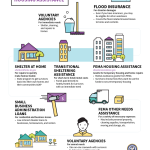RALEIGH, N.C. – Homeowners, renters and business owners in Greene, Harnett and Sampson counties may apply for federal disaster assistance for Hurricane Matthew damage and losses in North Carolina.
The fourteen counties already eligible to apply for assistance under FEMA’s Individual and Households Program are Beaufort, Bertie, Bladen, Columbus, Cumberland, Edgecombe, Hoke, Johnston, Lenoir, Nash, Pitt, Robeson, Wayne and Wilson counties.
Storm damage and losses from the hurricane and flooding must have occurred beginning October 4th.
Survivors are encouraged to register with FEMA as soon as possible. If you have phone and/or internet access, you may register in one of the following ways:
-
Online at DisasterAssistance.gov
-
Download the FEMA Mobile App
-
Phone 800-621-3362 (FEMA). Applicants who use 711 or Video Relay Service may also call
800-621-3362. Persons who are deaf, hard of hearing or have a speech disability and use TTY may call 800-462-7585.
-
The toll-free numbers are open from 7 a.m. to 11 p.m., seven days a week.
-
Multilingual operators are available.
For those who do not have access to telephone or internet service, don’t be discouraged. North Carolina Emergency Management and FEMA are coming to you. Teams of State and FEMA survivor assistance specialists will be moving into affected communities soon to help people register for assistance. Additionally, disaster recovery centers are being planned and will open in the near future in affected counties.
Assistance for eligible survivors can include grants for temporary housing and home repairs, and for other serious disaster-related needs, such as medical and dental expenses or funeral and burial costs. Long-term, low-interest disaster loans from the U.S. Small Business Administration (SBA) also may be available to cover losses not fully compensated by insurance and do not duplicate benefits of other agencies or organizations.
Survivors should also contact their insurance company to file an insurance claim. FEMA is unable to duplicate insurance payments. However, those without insurance or those who may be underinsured may still receive help after their insurance claims have been settled.
###
Disaster recovery assistance is available without regard to race, color, religion, nationality, sex, age, disability, English proficiency or economic status. If you or someone you know has been discriminated against, call FEMA toll-free at 800-621-3362 or TTY at 800-462-7585.
FEMA’s mission is to support our citizens and first responders to ensure that as a nation we work together to build, sustain, and improve our capability to prepare for, protect against, respond to, recover from, and mitigate all hazards.
The latest updates on road closures can be found at ReadyNC.org or by calling 5-1-1. Residents can also get real-time traffic and weather on the ReadyNC mobile app. People or organizations that want to help ensure North Carolina recovers can visit NCdisasterrelief.org or text NCRecovers to 30306. Follow us on Facebook at NCEmergencyManagement and Twitter @NCEmergency or @femaregion4.
The U.S. Small Business Administration (SBA) is the federal government’s primary source of money for the long-term rebuilding of disaster-damaged private property. SBA helps homeowners, renters, businesses of all sizes, and private non-profit organizations fund repairs or rebuilding efforts and cover the cost of replacing lost or disaster-damaged personal property. These disaster loans cover losses not fully compensated by insurance or other recoveries and do not duplicate benefits of other agencies or organizations. For more information, applicants may contact SBA’s Customer Service Center by calling (800) 659-2955, emailing disastercustomerservice@sba.gov, or visiting SBA’s Web site at www.sba.gov/disaster. Deaf and hard-of-hearing individuals may call (800)877-8339.
More here:
Survivors in Greene, Hartnett and Sampson Counties May Apply for Disaster Assistance




